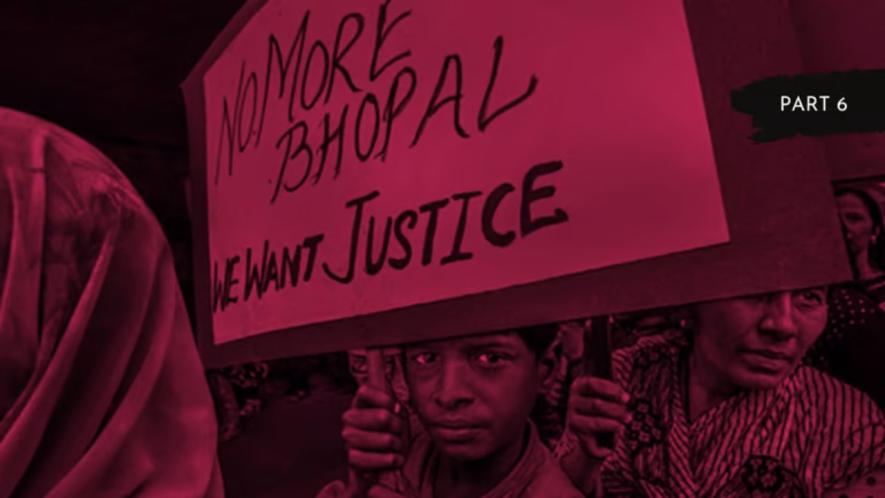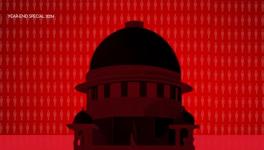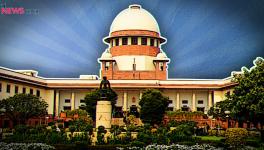Bhopal Gas Tragedy: Forty Years of Struggle For Justice—Part 6

The victims were not consulted. According to the Supreme Court: “Learned counsel for both parties stated that they would leave it to the court to decide what should be the figure of compensation.
“The range of choice for the court in regard to the figure was, therefore, between the maximum of US $426 million offered by Shri Nariman and the minimum of US $500 million suggested by the learned Attorney General.” [Order dated 4.5.89.pdf, Para 1, p. 542]
When and where did such negotiations take place? Such negotiations certainly did not take place in the presence of representatives of victims’ groups, who were interveners in the matter, or in the open court, where the hearing was confined to the quantum of interim relief to be paid by the Union Carbide Corporation (UCC).
In other words, the settlement was the outcome of secret negotiations conducted between the UCC and the government of India behind the backs of gas victims. However, the Supreme Court further tried to justify the settlement by observing that:
“The [settlement] Order was also made on the premise that the Bhopal Gas Leak Disaster (Registration and Processing of Claims) Act, 1985 was a valid law.” [Baxi & Dhanda (1990), Para 3, p. 542]
Since the Supreme Court referred to the Bhopal Act of 1985 to justify the settlement by claiming that Section 3 of the Act had empowered the Union government to represent the gas victims, how and why did the same court fail to take due note of the significance of Section 4 of the same Act?
It was left to another Constitution Bench of the Supreme Court, which in its judgment dated December 22, 1989 [(1990) 1 SCC 613] on the constitutional validity of the Bhopal Act, had pronounced on the implications of Section 4 of the Bhopal Act as follows: “In our opinion, the constitutional requirements, the language of the Section, the purpose of the Act and the principles of natural justice lead us to this interpretation of Section 4 of the Act that in case of a proposed or contemplated settlement, notice should be given to the victims who are affected or whose rights are to be affected to ascertain their views.
“Section 4 is significant. It enjoins the Central government, only to have ‘due regard to any matters which such person may require to be urged’. So, the obligation is on the Central government, in the situation contemplated by Section 4 to have due regard to the views of the victims and that obligation cannot be discharged by the Central government unless the victims are told that a settlement is proposed, intended or contemplated.” [Baxi & Dhanda (1990), Para 117, p. 610]
In other words, the settlement was the outcome of secret negotiations conducted between the UCC and the government of India behind the backs of gas victims.
Further adding that: “In the aforesaid view of the matter, in our opinion, notice was necessary. The victims at large did not have the notice.” [Baxi & Dhanda (1990), Para 119, p. 610]
In other words, it is an undeniable fact that the settlement process was consciously concealed from the gas victims by the Union government by not serving them prior notice regarding the proposed settlement, which was an essential requirement under Section 4 of the Bhopal Act.
As a result, as is evident now, the Union government had completely acquiesced to the terms set by the UCC and was, thereby, guilty of compromising the interests of the gas victims.
However, instead of taking the Union government to task for the grave misdemeanour, the Supreme Court chose to condone the Union government’s wholly unjustifiable act by observing as follows: “[I]t cannot be said that injustice has been done. ‘To do a great right’ after all, it is permissible sometimes ‘to do a little wrong’. In the facts and circumstances of the case, this is one of those rare occasions.” [Baxi & Dhanda (1990), Para 124, p. 613]
All these years, the gas victims have been left wondering what was so “great” or what was so “right” about the unjust settlement, which Prof. Upendra Baxi, the eminent legal scholar, has described as “the second Bhopal catastrophe”. [Baxi & Dhanda (1990), Para 2, p. (i)]
Basis of the settlement sum
Again, in an attempt to justify the reasons for the settlement sum remaining low in the settlement Order, in the Explanatory Order dated May 04, 1989, the Supreme Court threw a challenge as follows: “We should make it clear if any material is placed before this court from which a reasonable inference is possible that the Union Carbide Corporation had, at any time earlier, offered to pay any sum higher than an out-right down payment of US $470 million, this court would straightway initiate suo motu action requiring the concerned parties to show cause why the Order dated February 14, 1989 should not be set aside and the parties relegated to their respective original positions.” [Baxi & Dhanda (1990), Para 4, p. 542]
However, the Supreme Court desisted from throwing a similar challenge regarding the quantum of compensation that the Union of India had actually sought from the UCC.
Neither in the explanatory Order dated May 4, 1989 [(1989) 3 SCC 38] nor in the review judgment dated October 3, 1991 [(1991) 4 SCC 584] is there a reference to the total amount of compensation that the Union government had actually sought from the UCC. The truth was, in the amended plaint of the Union of India dated January 29, 1988, it is stated as follows: “It is estimated that the approximate value of the total claims (including deaths and personal injury cases) would exceed ₹3,900 crore (US $3 billion) if the case is tried to judgment through all the stages.” [Baxi & Dhanda (1990), Para 42, p. 193]
The Union government had completely acquiesced to the terms set by the UCC and was, thereby, guilty of compromising the interests of the gas victims.
On the contrary, the Supreme Court’s claim that the Union of India had sought a minimum of just US $500 million is not part of any public record other than being first mentioned in the explanatory Order dated May 4, 1989 [(1989) 3 SCC 38] and subsequently. Incidentally, the judgment on the constitutional validity of the Bhopal Act [(1990) 1 SCC 613] observed as follows:
“On November 30, 1986, the district court, Bhopal lifted the injunction against the UCC selling assets on the strength of the written undertaking by the UCC to maintain unencumbered assets of US $3 billion.” [Baxi & Dhanda (1990), Para 10, p. 553)
Certainly, if the UCC was compelled to maintain US $3 billion worth of unencumbered assets, it must have been based on the Union government’s quantum of claim for damages from the UCC and not for any other reason.
The Union government had reiterated this public position in the amended plaint it had filed on January 29, 1988 before the district court of Bhopal. [Baxi & Dhanda (1990), Para 42, p. 193]
Therefore, what possible justification can the Union government offer for surreptitiously claiming merely one-sixth of that amount as the final settlement amount?
It is so unfortunate that the Supreme Court has made no reference to the Union government’s original claim amount of US $3 billion as compensation either in the explanatory Order dated May 4, 1989 or in its review judgment dated October 3, 1991. At the same time, the court, in its Order dated February 15, 1989, had no hesitation in directing as follows:
“The undertaking given by Union Carbide Corporation pursuant to the Order dated November 30, 1986 in the district court, Bhopal shall stand discharged…” [Baxi & Dhanda (1990), Para 4(a), p. 528]
All these years, the gas victims have been left wondering what was so “great” or what was so “right” about the unjust settlement.
The UCC could not have hoped for a more favourable verdict from the Supreme Court of India!
Magnitude and gravity of impact
It did appear strange that no mention was made of the basis on which the settlement sum of US $470 million was quantified since nothing about the magnitude and gravity of the impact of the Bhopal catastrophe on living beings and the environment found a mention in the settlement Orders dated February 14–15, 1989 [(1989) 1 SCC 674 & 676].
Faced with widespread criticisms against this lacuna and other questionable terms of the settlement, the Supreme Court was compelled to issue the said explanatory Order on May 4, 1989 [(1989) 3 SCC 38].
In the explanatory Order, the Supreme Court’s ill-considered remarks regarding the magnitude and gravity of the impact of the catastrophe are really baffling. Without any input from any source, the court jumped to far-reaching conclusions as follows:
“There are a large number of claims under the Act. In the very nature of the situation, doubts that a sizeable number of them are either without any just basis or were otherwise exaggerated could not be ruled out.” [Baxi & Dhanda (1990), Para 2, p. 543]
How did the Supreme Court reach the conclusion “that a sizeable number of them [claims] are either without any just basis or were otherwise exaggerated?” Had anyone scrutinised the veracity of the claims and informed the court accordingly? That does not appear to be the case. As per available information, just prior to the settlement, the total number of claims filed for compensation crossed 5,50,000. [Baxi & Dhanda (1990), Para 3, p. 444]
However, as far as information on the total number of claims actually scrutinised or processed was concerned, the available number was just 60,000 as on December 8, 1987. [Baxi & Danda (1990), Para 5, p. 260]
Due to the failure on the part of the Union of India to disclose further information about the total number of claims processed or scrutinised, the UCC in its affidavit dated September 12, 1988 submitted to the Supreme Court that in its sur-rejoinder dated July 29, 1988 it had pointed out as follows:
Certainly, if the UCC was compelled to maintain US $3 billion worth of unencumbered assets, it must have been based on the Union government’s quantum of claim for damages from the UCC and not for any other reason.
“[N]o detailed processed claims or registers prepared were ever filed before the high court at any time.” [Baxi & Dhanda (1990), Para 1, p. 502]
If the Union of India had not submitted any information either to the high court or to the Supreme Court on the total number of processed or scrutinised claims, how could the Supreme Court arrogate to itself the right to cast aspersions of the veracity of the vast majority of the 5,50,000+ claims filed by gas victims?
Why did the Supreme Court not take the Union government to task for not only failing to scrutinise the claims but also for not setting up claim courts for adjudicating the claims for four long years?
Undisputed figures?
After casting unwarranted aspersions on the total number of claims filed, the Supreme Court went on to identify what was described as “prima facie undisputed figures”:
“It was, therefore, thought not unreasonable to proceed on some prima facie undisputed figures of cases of death and of substantially compensable personal injuries. The particulars of the number of persons treated at the hospitals were an important indicator on that behalf.
“This court had no reason to doubt the bona fides of the figures furnished by the plaintiff itself in the pleadings as to the number of persons suffering serious injuries.” [Baxi & Dhanda (1990), Para 2, p. 543]
How did the Supreme Court arrive at the conclusion that the hospitals and clinics, where gas victims were treated were maintaining proper and complete medical records of all the gas victims?
How could the Supreme Court have taken at face value the figures produced by the Union and state governments when the truth was that no efforts were made by the government to maintain proper and complete medical records of several hundreds of thousands of gas victims, who underwent medical treatment at various permanent hospitals and clinics not only in Bhopal but in the surrounding areas as well for several months if not several years after the catastrophe?
Moreover, numerous temporary medical camps were set up by voluntary organisations in Bhopal soon after the catastrophe. Did the government make any attempt to collate all those medical records?
What possible justification can the Union government offer for surreptitiously claiming merely one-sixth of that amount as the final settlement amount?
The unwillingness to maintain proper and complete medical records of all gas victims has been the biggest misdeed of the Union and state governments. Therefore, the decision of the Supreme Court to rely on partial and hypothetical figures of dead and injured to quantify the settlement sum was not only injudicious but also a huge error of judgment on its part.
Gross underestimation
Based on such erroneous assessment, the Supreme Court reached the conclusion— as noted in its Explanatory Order dated May 4, 1989— that only around 3,000 victims had died due to the impact of the catastrophe; that victims with injuries of utmost severity were just 2,000; that only around 30,000 victims had sustained serious injuries; that another 20,000 victims had suffered moderate injuries; and that another 50,000 victims had suffered minor injuries.
The Supreme Court on its own had further assumed that 50,000 claims had been filed for loss of livestock and another 50,000 claims had been filed for loss of property— assumptions that had absolutely no basis. [Baxi & Dhanda (1990), pp. 544–545]
On the contrary, as is evident from the Annual Report (2021–22) of the Bhopal Gas Tragedy Relief and Rehabilitation Department (BGTRRD) of the government of Madhya Pradesh, a total of 618,659 claims had been filed until 1989 (i.e., till the time of the settlement) out of which claims on account of personal injury numbered 597,908; claims by next of kin on account of death were 15,310; claims due to loss of livestock were 612; claims due to loss of property were 4,745; and claims by government agencies were 84. [See Varshik Prashaskiya Prativedan 2021–2022 (Part1).pdf, p. 35]
If 15,310 claims on account of death had been filed until 1989, how did the Supreme Court reach the conclusion that only 3,000 of them had actually died due to the catastrophe even without a preliminary examination of the veracity of those 15,310 claims?
The UCC could not have hoped for a more favourable verdict from the Supreme Court of India!
Similarly, if 597,908 claims had been filed on account of personal injury, how did the Supreme Court reach the conclusion that only 102,000 of them had sustained any form of injury when only around 60,000 of the 597,908 claims had been processed or scrutinised? None of the claims had been adjudicated until then— that process began only in August 1992.
How could the Supreme Court declare in the Explanatory Order dated May 4, 1989, that nearly 500,000 claims are bogus even before carrying out a preliminary examination of the veracity of those claims? [Baxi & Dhanda (1990), Para 2, p. 543]
Was it not patently unjust on the part of the Supreme Court to have ordered a settlement solely based on hypothetical estimates of dead and injured?
At the same time, on what basis did the Supreme Court allocate compensation to 50,000 cases each on account of loss of livestock and loss of property when only about 612 claims on account of loss of livestock and 4,745 claims on account of loss of property had been filed?
Therefore, there is little doubt that the Supreme Court had relied on guesstimates and nothing else to quantify the settlement figures of dead and injured.
To pass off mere guesstimates as “prima facie undisputed figures” was totally unbecoming on the part of the Supreme Court. No wonder that the Supreme Court itself expressed self-doubt about its conclusions by admitting in its Explanatory Order dated May 4, 1989, as follows:
“A settlement has been recorded upon material and in circumstances which persuaded the court that it was a just settlement. This is not to say that this court will shut out any important material and compelling circumstances that might impose a duty on it to exercise the powers of review. Like all other human institutions, this court is human and fallible.” [Baxi & Dhanda (1990), Para 2, p. 548]
The court further added: “If, owing to the pre-settlement procedures being limited to the main contestants in the appeal, the benefit of some contrary or supplemental information or material, having a crucial bearing on the fundamental assumptions basic to the settlement, have been denied to the court and that, as a result, serious miscarriage of justice, violating the constitutional and legal rights of the persons affected, has been occasioned, it will be the endeavour of this court to undo any such injustice.
Therefore, there is little doubt that the Supreme Court had relied on guesstimates and nothing else to quantify the settlement figures of dead and injured.
“But that, we reiterate, must be by procedures recognised by law. Those who trust this court will not have cause for despair.” [Baxi & Dhanda (1990), Para 2, p. 548–549]
The gas victims did repose faith in the Supreme Court; the gas victims have followed all procedures recognised by law; yet, unfortunately, justice has not been delivered to the gas victims even 40 years after the catastrophe.
Read Part 1 here.
Read Part 2 here.
Read Part 3 here.
Read Part 4 here.
Read Part 5 here.
Get the latest reports & analysis with people's perspective on Protests, movements & deep analytical videos, discussions of the current affairs in your Telegram app. Subscribe to NewsClick's Telegram channel & get Real-Time updates on stories, as they get published on our website.
























